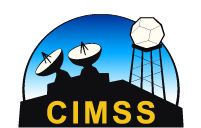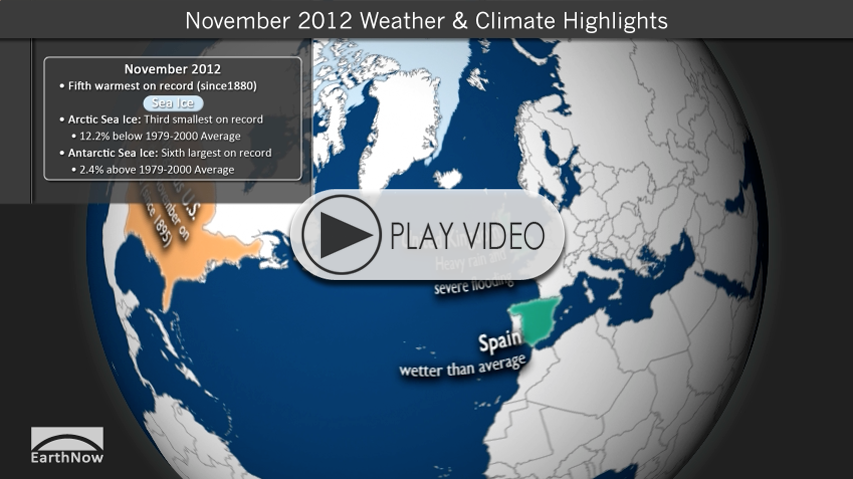
Climate Digest Video • iPad Video
SOS Playlists
 SOS Playlist
SOS Playlist
Overview
Each month, we will provide information regarding the previous month’s climate. Overall, preliminary data analysis suggests that November 2012 was the fifth warmest on record (since 1880). Major stories include drought in the United States, flooding in Argentina, and the devastating impacts of Typhoon Bopha. More detailed information follows.
-
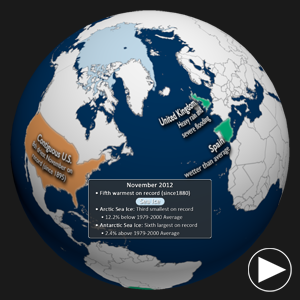
November 2012 Highlights Sphere Preview • iPad Video
Highlights Dataset
Dataset Name: 20121219 EarthNow: November 2012 Highlights
 Full Map Image
Full Map Image
- This dataset shows some of the major November weather and climate highlights from the National Climatic Data Center’s (NCDC) monthly global climate analysis, and serves as an overview of what can be discussed in the datasets that follow. Highlights are noted below with more information.
- United States: At the end of November, about 76% of the country was considered to be abnormally drought or experiencing exceptional drought. It is the country’s eighth driest November on record (since 1895).
- Argentina: Portions of Argentina experienced strong storms, leading to heavy rain and severe flooding.
- Australia: The average November maximum temperature was the fourth highest on record.
- Typhoon Bopha: (November 25 – December 9); Max. winds: 260 km/hr; Bopha made landfall as a category 5 storm, killing over 700 people, with around 900 people still missing.
- South Korea: Experienced its fifth lowest November maximum temperature average on record (since 1973).
- United Kingdom: Heavy rain resulted in severe flooding. Some areas received twice the month’s normal rainfall in one week.
- Spain: wetter than average conditions.
- Arctic Sea Ice Extent: Third smallest on record, at 12.2% below the 1979-2000 average.
- Antarctic Sea Ice Extent: Sixth largest on record, as 2.4% above the 1979-2000 average.
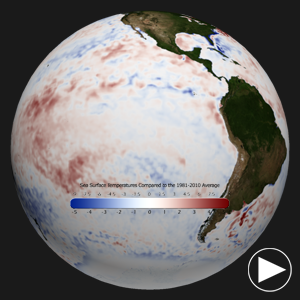
SST Anomalies Sphere Preview • iPad Video
Sea Surface Temperature Anomalies Dataset
Dataset Name: 20121219 EarthNow: RT SST Anomalies
 Full Map Image
Full Map Image
- The real-time sea surface temperature anomaly dataset is a great way to visualize the El Niño – Southern Oscillation (ENSO) cycle in the eastern tropical Pacific ocean. This helps show the moderate water waters, indicating an ENSO Neutral period.
- Remember that the blues indicate cooler than average temperatures and reds indicate warmer than average temperatures (white: average).
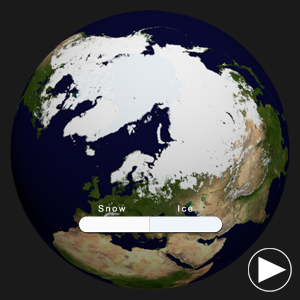
Snow and Ice Sphere Preview • iPad Video
Snow and Ice Cover Dataset
Dataset Name: 20121219 EarthNow: RT Snow and Ice Cover
 Full Map Image
Full Map Image
- Aside from helping to illustrate seasonal changes, the real-time Snow and Ice Cover dataset is a great way to convey sea ice change through time, including discussing how the current sea ice extent compares to other noteworthy years.
- The Arctic sea ice extent in November was the third smallest on record. The extent was 12.2% below the 1979-2000 average.
- In Antarctica, the sea ice extent was the sixth largest on record, at 2.4% above the 1979-2000 average.
Where do I find the datasets?
-
First, check your SOS system to make sure it’s not already in the EarthNow category.
-
If not, you can download the datasets and playlist files from this FTP Site.
-
Then download and use playlist files at the top of the page (or create your own) and make sure they are in /home/sos/sosrc or /home/sosdemo/sosrc.
Helpful Resources for More Information
-
http://www.ncdc.noaa.gov/oa/ncdc.html National Climatic Data Center (NCDC)
-
http://www.ncdc.noaa.gov/teleconnections/enso/enso-tech.php About ENSO (El Niño/La Niña)
-
http://www.ncdc.noaa.gov/sotc/global/ NCDC’s Global Climate Report





